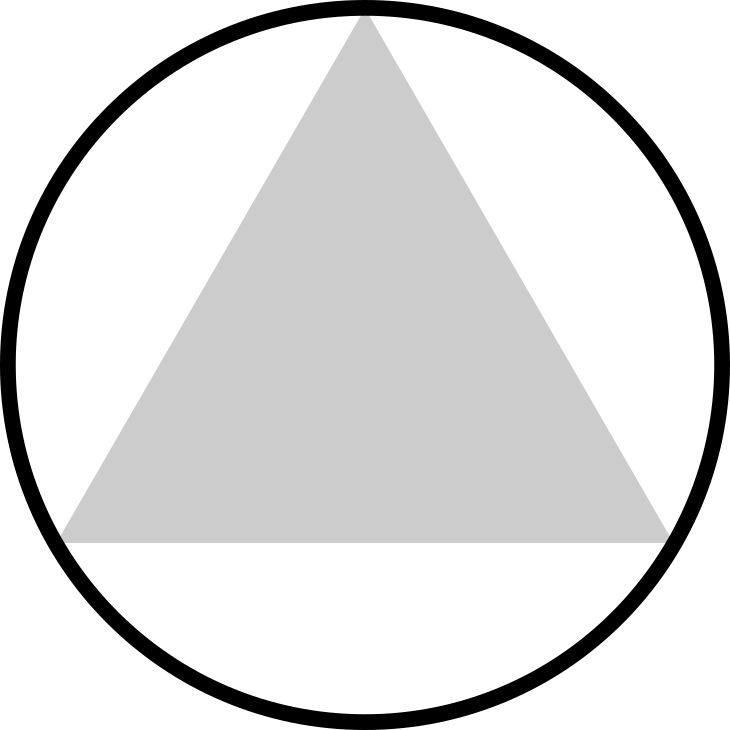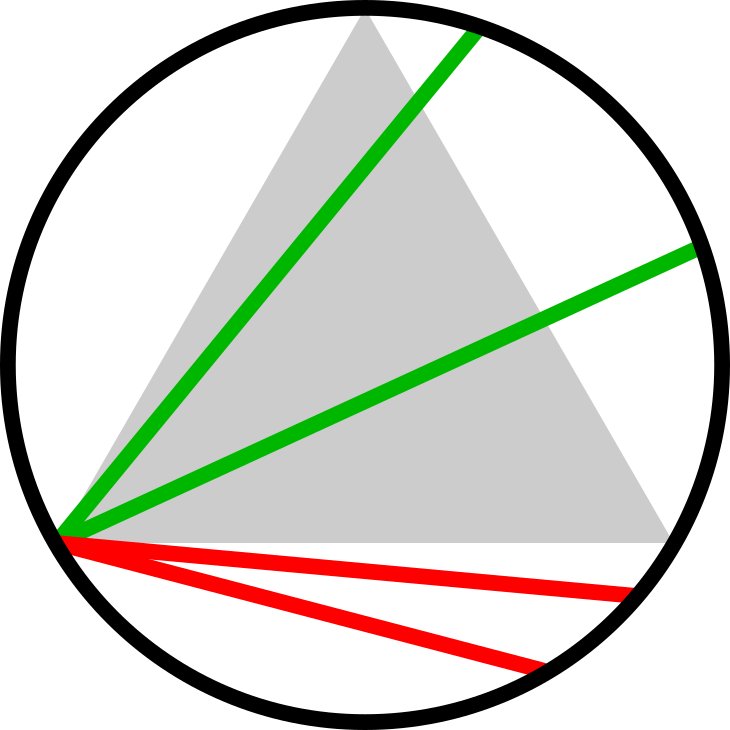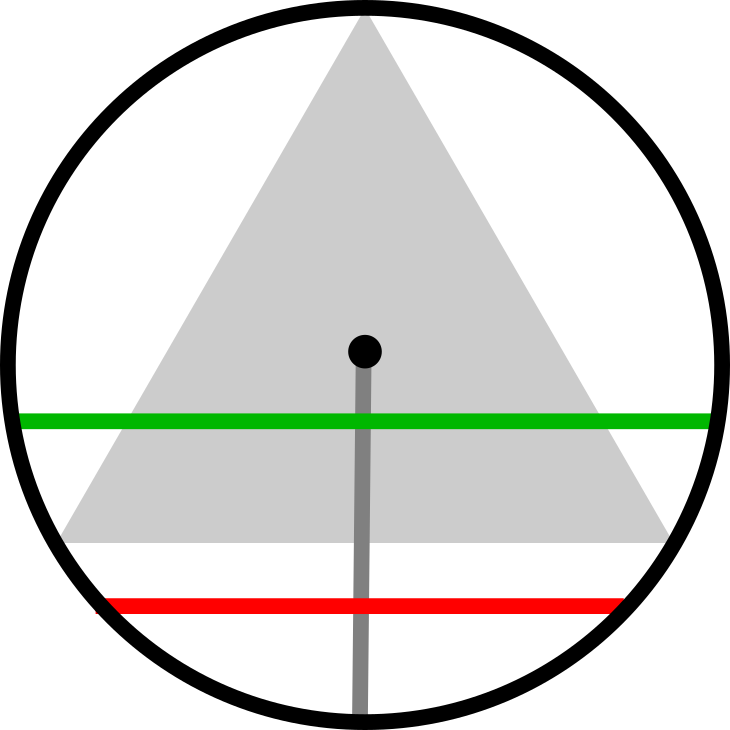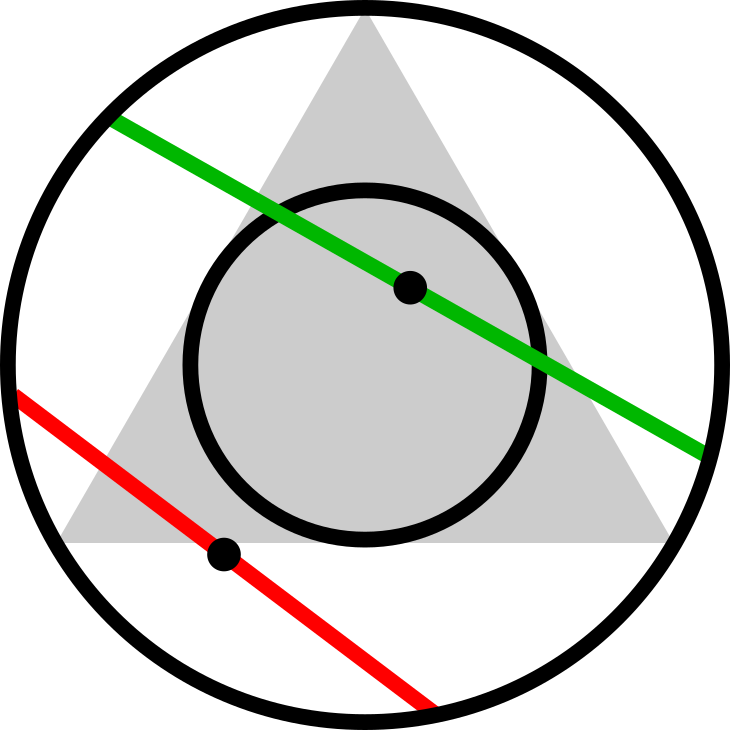Striking a chord
BLOG: Heidelberg Laureate Forum

Here’s a puzzle. Imagine you have a circle, and inside the circle is an equilateral triangle – one which touches the circle at each of its corners, so it’s as big as it can be inside the triangle. (There’s exactly one such triangle, since it being equilateral means it has all three sides the same length, and that length is specified by the size of the circle – although which way up the triangle is inside the circle would be a matter of personal preference).

Now you’re imagining a triangle in a circle (or looking at this picture of one), we’re ready to set the puzzle – well, nearly. We need one more definition: a chord is a line that runs from one point on the edge of a circle to another point somewhere else on the circle. (It could run across the middle, through the centre of the circle, or be just between two points quite close together on the edge, or anything in between – and it can also point in any direction). This means the length of the chord could be anything between 0 (if it’s from a point to itself) and the full diameter of the circle.
Ok, so now we have a circle with a triangle in, and the notion of a chord, here’s the puzzle.
If I pick a chord at random on a circle, what’s the probability that the length of this chord is longer than the side length of the triangle?
I’ll give you a minute to think about it – go away now and see if you can come up with an answer you’re happy with. Then I’ll explain a little more.
Chord-iality
This puzzle is the root of a piece of mathematics called the Bertrand Paradox, and it’s based on a concept called the Principle of Indifference. This relates to the notion of what we mean by ‘a random chord’. If you wanted to pick something like a chord at random, you could work out all the possible chords you can generate on a circle, and assume each one is equally probable since it’s being picked at random from all the possibilities.
The problem with this is that it runs into difficulty when you have to decide how you’re defining a chord. For instance, you may have spotted that if your chord is just defined by picking two points on the edge of the circle, it doesn’t matter where one of them is, as you can pick the other one relative to it. So, (as mathematicians love to say) without loss of generality, we can pick one of the points where the triangle touches the circle as one end of our chord. Then any possible chord will be defined by where the other end of the chord hits the circle.

Now the problem becomes fairly straightforward – if we pick an endpoint for the chord that lies between the other two points of the triangle, the resulting chord will be longer than the side of the triangle, and if we pick one that lies between the starting point and one of the corners, it’ll be shorter. Given that picking any point around the triangle is equally likely, this means it just depends on what proportion of the edge of the circle is in each area – and since our triangle divides the edge of the circle into nice thirds, two-thirds of this will give shorter chords, and the one-third in the middle gives longer chords. So the answer to the puzzle is ⅓!
This all seems very sensible – but this might not be the way you’ve chosen to define your chords. For example, another completely valid way to define a chord of a circle is to think of it as being perpendicular to a radius of the circle – wherever your chord is, you can draw a line that crosses it at right angles which goes through the centre of the circle.
Then you can define the chord by the angle of the radius it’s perpendicular to, and the perpendicular distance between the centre of the circle and the chord along that radius. (If you’re not convinced of this, try drawing a random chord, then seeing if you can construct the radius it’s perpendicular to – it’ll always cross the radius in the middle of the chord!)

If you’re defining chords this way, then checking whether they’re longer or shorter than the triangle side is also relatively simple – once you’ve picked your chord, you can rotate the triangle in the circle so the base of the triangle is parallel to your chord. Then, if the chord is closer to the centre of the circle than the edge of the triangle is, it’ll be longer, and if it’s further away it’s shorter. Since you can rotate the triangle to make this comparison, the angle of your chord is irrelevant – all that matters is the distance away from the centre.
Since the size of the equilateral triangle is fixed relative to the circle, we know how far along the radius the triangle edge would be – and based on our answer using the previous method, you might expect it to be ⅓, so that ⅓ of the chords are longer and ⅔ are shorter, as previously. But it’s not – the triangle edge lies exactly halfway along the radius (again, if you’re not convinced, it’s a slightly fun thing to try and prove – you end up with a smaller equilateral triangle). So if you define chords this way, the chance of them being longer than the triangle side is now ½.

And it gets worse. A third way to define a chord is by picking a random point inside the circle, and making a chord with that point as its midpoint (this is uniquely defined for any point inside the circle that isn’t the centre). If you do it this way, chords longer than the triangle side will have midpoints that lie inside a circle in the middle of the bigger circle with half the radius, and the proportion of the area of the circle this covers will give you the proportion of chords longer than the triangle side – and since the circle has half the radius, it has a quarter of the area… so now the answer is ¼!
You might at this point start to worry. Maybe mathematics isn’t the infallible logical bastion of sense in a chaotic universe you thought it is, and if you think about an already-solved maths problem in too many different ways you might start to get different answers! But don’t worry. The Bertrand paradox really is a paradox, and depending on how you define a ‘randomly chosen chord’, you get different answers – because the probability of choosing any particular chord is quite a slippery thing to define.
Dis-chord
Earlier I briefly mentioned that picking a random chord by choosing a midpoint gives you a unique answer as long as you don’t pick the centre of the circle – any diameter of the circle will work as a chord with that midpoint. But doesn’t this mean that even if this area contains ¼ of the midpoints, it doesn’t necessarily follow that it contains ¼ of the chords? Is that even a meaningful thing to think about, since there are infinitely many chords?
Similarly, if we pick our chord by choosing a distance away from the center, using the second method, we could pick the distance 0 and find ourselves looking at the diameter of the circle. But we’d get the exact same chord (the diameter) by using the angle 180° around from that point – and this means we’ve counted it twice.
This will affect the probability since we consider these two lines to be different, but by other methods, they’d be counted as the same. In the choosing-a-second-endpoint method, each chord can only be picked exactly once, since there’s only one point on the circle that gives that chord (including the diameter).
So the diameter, which is a special case of a chord, gets counted a different number of times using each of these methods – which maybe gives a hint as to why this problem behaves so strangely. But it’s not just the diameters that mess things up – if you plot, say, the first 250 chords randomly generated using each method, they’re distributed differently on the shape, and this is why the probabilities turn out to be different depending on the method you use.

(L-R: random endpoints, random angle and distance from centre, random midpoint)
In fact, it’s not really meaningful to talk about the probability of picking a particular chord – since there are infinitely many possible chords within the circle, the probability of picking any one chord is actually 0. This is one of the quirks of probability distributions on infinite sets – if, for instance, I pick a random number in the interval between 0 and 1, I can tell you the probability that it lies between 0 and ½, which is ½, but for any given number the probability of picking it is 0, because there are infinitely many to choose from.
Picking a chord within a circle is (it turns out) more complicated than just picking a number from an interval – you can’t just apply the principle of indifference, since the distribution you get will depend on the method you use. In fact, unless you specify in the question which selection method is being used, the puzzle has no well-defined unique answer. Sorry!
This shouldn’t put you off trying to answer probability questions – especially ones to do with infinite sets – but it does mean you need to think carefully about your answer. Joseph Bertrand introduced this paradox as an example of when applying principles uncritically can lead to ambiguity, and it serves as a reminder that while maths can tell us a lot about the universe, it’s a tool that needs to be used intelligently.

